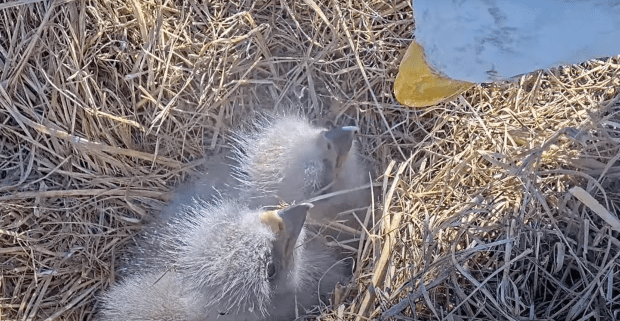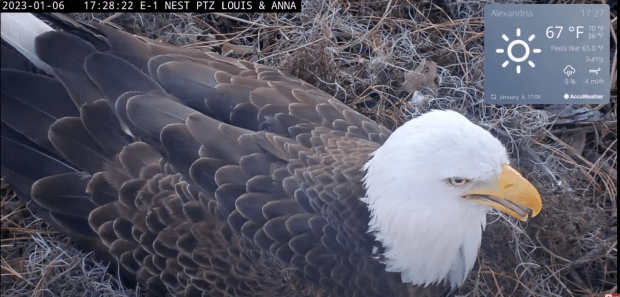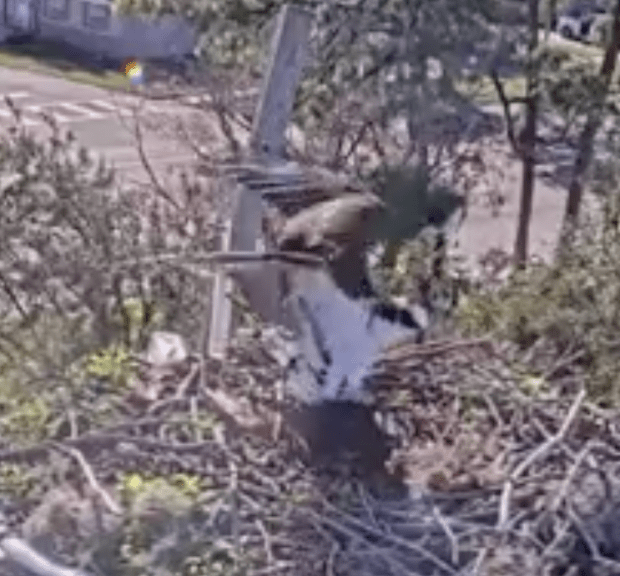10 January 2022
Good Morning,
Lots of eagle parents busy feeding eaglets – from those a month old at Superbeaks to newly hatched. It is ‘egg citing’.
Making News: Hopefully all manner of organisations and individuals will keep a very focused light on the gaming estates in the UK. Will the judiciary finally give sentences to gamekeepers that are appropriate for all the laws that they have broken? Will they give sentences and fines long and large enough to deter this horrific behaviour. Sue Belcher wrote a poem about snares. Read it. If you don’t live in the UK but love our raptors and other wildlife, it will help you to understand what the fight is about. I am happy to spread the word on the plight of wildlife caught in these medieval devices. Thank you Sue!

Checking on some of the nests we are watching:
At 11;22, Connie and Clive have their first hatch at the Captiva Bald Eagle cam. It is to be really celebrated. Connie and Joe lost their two beautiful hatches, Peace and Love, to rodenticide secondary poisoning in 2020. No eggs in 2021. Then Hurricane Ian came and tore down Connie and her new mate’s nest, Joe. Congratulations Captiva!


Jackie often lays her eggs in March. Generally egg laying is timed to the availability of prey items. Despite that historic fact, Shadow and Jackie have been mating on the nest today and Jackie continues to check out the nest bowl. Will we have eggs early at Big Bear Valley?
It started off as another f/soggy day at the Kisatchie Forest nest of Alex and Andria. ‘A’ was the first to alert me to the fact that the weather is often very different on one side of the lake from the other. Andria dig a really good job keeping those feisty little eaglets with their clown feet underneath her so they would stay warm and dry. No thermal down yet so this is important. It is coming!


More chair rails, Alex!!!

E3-02 was so full that he could hardly get himself up and over to the dining table for the next meal.




As the sun set Monday night in Alexandria, Louisiana, two very full eaglets tucked in tight under Mum sleeping. Beautiful.

Eaglet E1-03 is a cutie pie! Louis is filling the nest with Coot and fish already. Anna has changed so much since her first hatch, Kisatchie. He didn’t know what to do and Anna didn’t know how to feed an eaglet. Of course, they got it together but, we sat at the edge of our seats. Now Anna is experienced and this little one is simply a cutie who loves its fish and Coot. Look at those precious wings.

Oh, such a chubby little baby. Cute. So cute.

If you have not watched the nest of Louis and Anna, it is a good one to have on your list. Here is the link:
This is the status of the pip for Connie and Clive at 17:41 Monday evening.

Both Gabby and V3 were in the nest at 06:51 Monday morning.

V3 was last seen at the tree at 1531. There had been an adult eagle land on the nest tree with an injured eye and talons but it would not have been V3.

At 18:05, Gabby waits on Wallenda. She is still tucked on Wallenda and waiting for V3at midnight.

At Superbeaks, Pearl appears to be doing some self-feeding.


And, oh, goodness. Every eaglet or osplet should know that you NEVER look your sibling directly in the eye. It is definitely not a good idea.

Big PS before bed.


At the nest of Harriet and M15, the two eaglets, E21 and E22, are doing grand. E21 is 6 days old today and E22 is 3.5 days old. That is actually a big difference. Both are eating well and Harriet is feeding them as much as each needs. E22 does not need as much food as E21 – so don’t panic and count the bites and worry if they are not equal! It is all good in Fort Myers on the Pritchett property.




Harriet gave E22 a private feeding while 21 slept – Harriet is experienced and smart! Lady Hawk put it on video for us.
Martin and Rosa have been doing restorations at the Dulles-Greenway Eagle Cam in W Virginia on Monday. Oh, those talons make me ache. Send some very soothing hand cream to the nest, please!


Indigo had a very interesting day. Check out Elain’s video:
So what is up with Annie and the ‘new guy’? I am not sure. He was till working on his prey deliveries the other day.
Book Review: Loon Lessons. Uncommon Encounters with the Great Northern Diver by James D Paruk (2021, University of Minnesota Press).

Loons. Who doesn’t love a loon? Anyone spending time in the forest and lake areas of Canada or Minnesota – or other places – has memories of their calls -the tremolo, yodel, or wail. I have tried hard to ‘see’ them because I have listened to those calls for years but, did not get sight of the diving waterfowl. I finally did. I will not tell you that I love loons more than big bad raptors – I don’t. But they are iconic for the province that I live in and I want to know more about them so I can appreciate their life, its blessings, and challenges more. This book really helped me on all accounts. The book is full of 30 years of experience by today’s leading expert on loons.
As a former academic, ‘scholarly’ articles can be a bit dry and daunting especially if they are in any of the fields of science (sorry). What I noticed immediately was that Paruk’s friendly and accessible writing style immediately drew me in. What a wonderful way to open a preface by saying, “To appreciate any organism, I am convinced we do not need years of training – all we need to do is watch our children marvel at a deer or a squirrel from a window. A sense of wonder and our innate curiosity can lay the foundation for developing and maintaining an appreciation for the natural world.” Excellent. The volume is divided into 12 chapters moving from biology, courtship and nesting behaviour, migration, conservation threats, and how loons are adapting to a changing world. The book is printed in black and white and at first you might ask, “where are the photographs of this magnificent bird with its black and white plumage”? You will find those images in the middle of the book – and I learned, looking through those images – that some loons have other coloured plumage such as the Red necked Loon!
Besides behaviour, one of the things that I was most interested in reading first were the challenges that loons face and what is being done to help them. You may have seen the artificial floating nests with avian guards (a bit of a camouflage cover over the top) on some loon streaming cams. These help the loons protect their nests and keep them safe from predators. The floating nests also keep the eggs out of harms way in times of flooding. It was very clear to me that the Bald Eagles who nest on the shore near Hecla Island and whose nests were destroyed by the 2022 flood might benefit from some floating platforms of some sort. There are other ways that we can help.
The threats to the loon sound like a broken record for all birds including raptors – mercury affects the central nervous system and it is present at very high levels in many of the ponds and lakes in the northern part of my province. As a natural occurring material, it was released into the water when the land was dredged for the many hydro-electric dams. Lead. Oh, what a culprit lead is – and please tell me why, knowing what it does to all birds and wildlife – has it not been banned? I clearly believe that humans that have the power to stop painful deaths or long term rehabilitation must wear bloody blinders. It is making me angry and I wonder how they would feel dying of lead poisoning? On page 173, Paruk states, “In recent decades, the EPA and USFWS failed to pass further measures to reduce the use of lead in hunting and fishing gear despite mounting evidence of its toxicity in the environment”. He continues by adding that six states took it upon themselves to pass legislation curtailing the use of certain levels of lead in fishing equipment. Those states are New Hampshire (sinkers 1 ounce or less), Massachusetts (lead sinkers on two reservoirs loons use for breeding), Maine, New York, Vermont banned “the sale of lead sinkers of one-half ounce or less and restarted their use as well.” Washington State banned the use of lead tackle on 12 of the 13 lakes used for breeding by loons. Since 2010, no additional state has done anything to ban lead ——–that was 13 years ago. It is time our American friends reading this blog get busy lobbying for the end of lead – the end of it period. Not just certain amounts. All lead. Paruk states, “I am left wondering how many more eagles, loons, condors, cranes, and swans have to die before a change in policy is warranted. The EPA was designed to protect the health of humans and the environment…acknowledges that lead is toxic to wildlife but not enough to warrant a national ban of lead tackle. Despite the mounting evidence that ingested fishing tackle leads to numerous wildlife deaths, the EPA refuses to recognise that there is a serious problem nationally. Because the federal government has failed to act on banning lead tackle, the responsibility shifts to state governments to take action” (174-75). If you want to do something to help the wildlife in the US, then US citizens reading my blog should carefully craft a letter to their state environmental officials copying them to the EPS and the USFWS demanding action now. Mercury and lead but there are also serious environmental threats to loons and other wildlife – including oil and its spillage such as The Deep Water Horizon in the Gulf. The other day I posted a copy of a Tweet indicating that licenses to drill for oil and natural gas off the coast of Alaska – pristine waters – were being accepted and had one application. Are they serious? Of course, monofilament fishing line is a source of painful injury or death. Other polluted waters, habitat loss, etc. The list is endless.
It is a really good read. You can learn so much just about loons, their behaviour and their migration but you can also get in deep with the challenges they face and how these might be rectified. Price in Canadian dollars: $34.95.
(Disclosure: I do not receive free books to review. If I see a new book that interests me, I buy it and am very happy to spread the word on those that will educate us, cause us to be curious, raise our awareness.)
Thank you so much for being with me today. Please take care. Looking forward to seeing you soon!
Thank you to the following for their notes, tweets, posts, announcements, videos, and streaming cams that make up my screen captures: @Belcherspoems, Window to Wildlife, FOBBV, KNF-1, KNF-3, Window to Wildlife, NEFL-AEF, Superbeaks, Lady Hawk and SWFL Bald Eagles and D Pritchett, Dulles-Greenway Bald Eagle Cam, Elain and Charles Sturt Falcon Cam and Cilla Kinross, Cal Falcons, and Amazon.












































